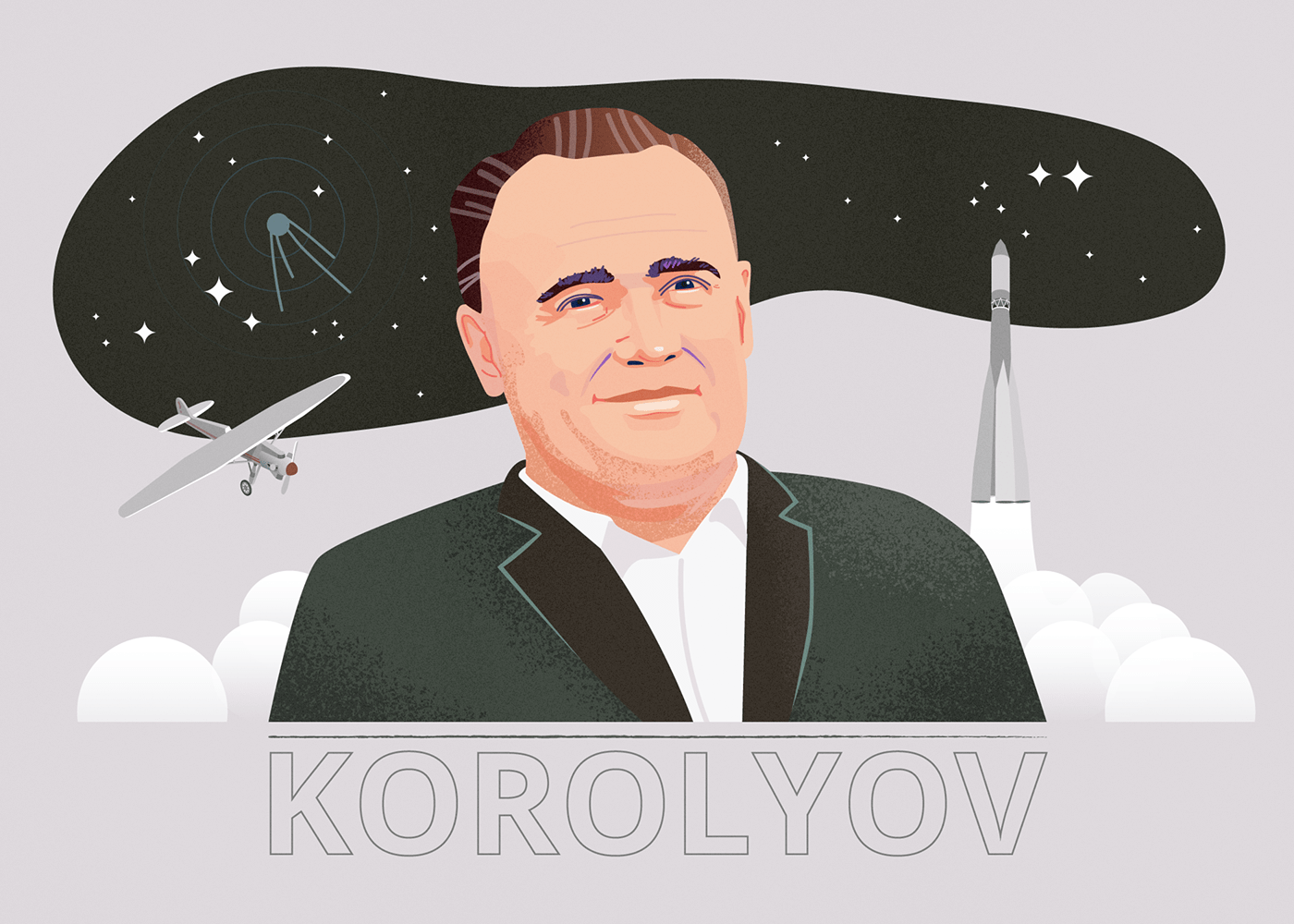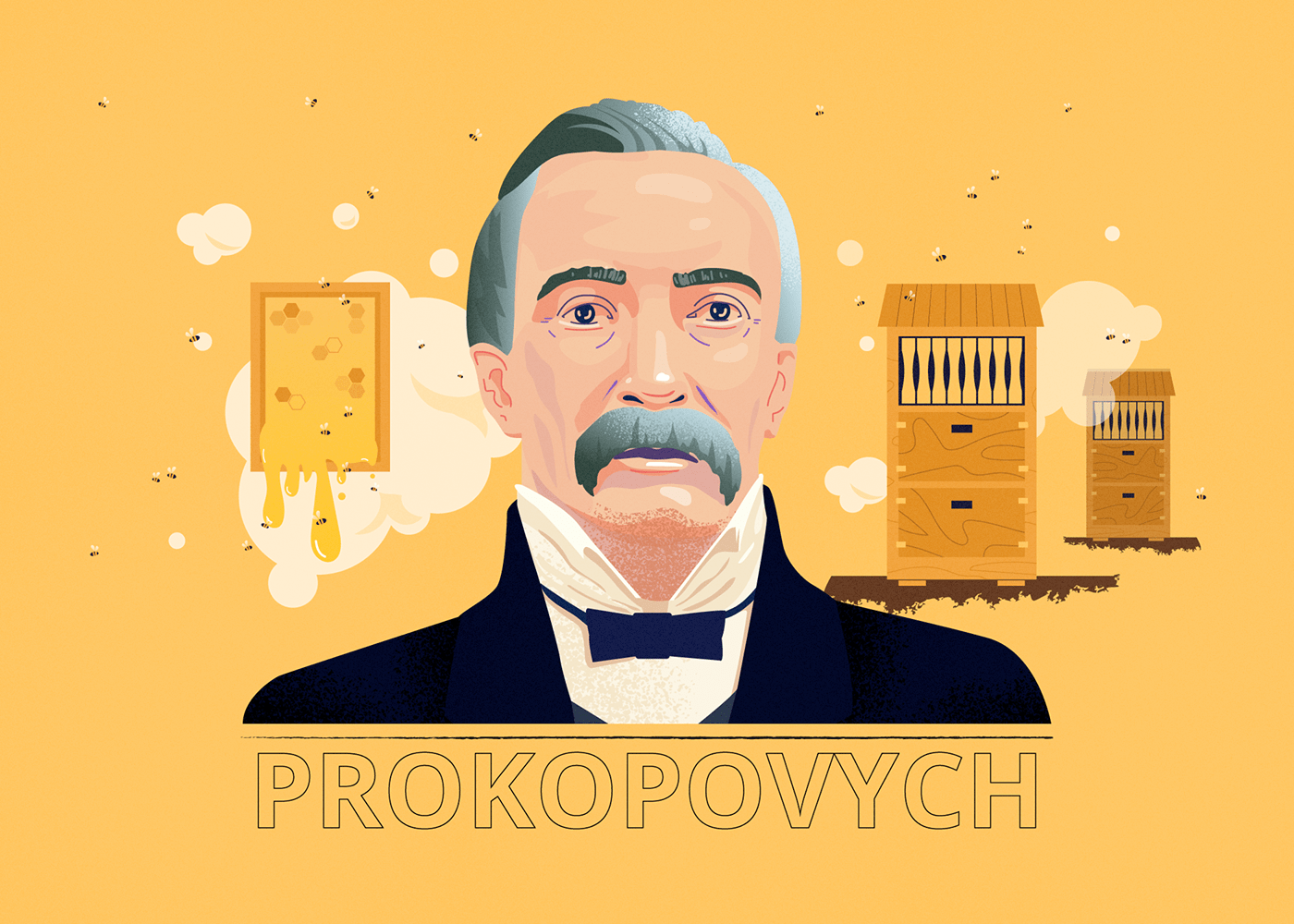Inventive minds:
A colorful tribute to Ukrainian innovators
A colorful tribute to Ukrainian innovators
Introducing "Inventive minds" – a captivating collection of custom illustrations highlighting famous Ukrainian inventors and their groundbreaking creations. This project brings together the brilliance of Ukrainian inventors throughout history, showcasing their remarkable contributions to science, medicine, engineering, and other fields.

Ihor Sikorsky
(1889-1972)
Ihor Sikorsky is an aviation pioneer of Ukrainian origin in both helicopters and fixed-wing aircraft.
After immigrating to the United States in 1919, Sikorsky founded the Sikorsky Aircraft Corporation in 1923, and developed the first of Pan American Airways' ocean-crossing flying boats in the 1930s.
In 1939, Sikorsky designed and flew the Vought-Sikorsky VS-300, the first viable American helicopter, which pioneered the rotor configuration used by most helicopters today. Sikorsky modified the design into the Sikorsky R-4, which became the world's first mass-produced helicopter in 1942.

Mykola Amosov
(1913-2002)
Mykola Amosov is a renowned Ukrainian cardiovascular surgeon, scientist, and writer. In 1965, he performed the first surgery operation on a heart mitral valve using antithrombotic prostheses, which he invented.
The clinic established by Amosov, produced about 7000 lung resections, more than 95000 operations for heart diseases, including about 36,000 operations with extra-corporeal blood circulation.
In 1983 Amosov's cardiac surgery clinic was reorganized in Kyiv Research Institute of Cardiovascular Surgery and in the Ukrainian Republican cardiovascular surgical center. Each year, the institute fulfilled about 3000 heart operations, including over 1500 - with extra-corporeal blood circulation.
The clinic established by Amosov, produced about 7000 lung resections, more than 95000 operations for heart diseases, including about 36,000 operations with extra-corporeal blood circulation.
In 1983 Amosov's cardiac surgery clinic was reorganized in Kyiv Research Institute of Cardiovascular Surgery and in the Ukrainian Republican cardiovascular surgical center. Each year, the institute fulfilled about 3000 heart operations, including over 1500 - with extra-corporeal blood circulation.

Serhiy Korolyov
(1907-1966)
Serhiy Korolyov was a lead Ukrainian (USSR, Ukrainian Soviet Socialist Republic) rocket engineer and spacecraft designer.
He is regarded by many as the father of practical astronautics. He was involved in the development of the R-7 Rocket, Sputnik 1, launching Laika, Sputnik 3, the first human-made object to make contact with another celestial body, Belka and Strelka, the first human being, Yuriy Gagarin, into space, Voskhod 1, and the first person, Oleksiy Leonov, to conduct a spacewalk.
He is regarded by many as the father of practical astronautics. He was involved in the development of the R-7 Rocket, Sputnik 1, launching Laika, Sputnik 3, the first human-made object to make contact with another celestial body, Belka and Strelka, the first human being, Yuriy Gagarin, into space, Voskhod 1, and the first person, Oleksiy Leonov, to conduct a spacewalk.

Ilya Mechnikov
(1845-1916)
Ilya Mechnikov was a prominent biologist and immunologist of Ukrainian origin.
Honoured as the "father of innate immunity", Mechnikov was the first to discover a process of immunity called phagocytosis and the cell responsible for it, called phagocyte, specifically macrophage, in 1882. This discovery turned out to be the major defence mechanism in innate immunity. In 1908, Ilya Mechnikov was awarded the Nobel Prize in Physiology or Medicine for the development of phagocytosis theory of the human immune system.
Mechnikov developed one of the earliest concepts in ageing, and advocated the use of lactic acid bacteria (Lactobacillus) for healthy and long life. This became the concept of probiotics in medicine.
He worked at the Odesa University that now bears his name.
Honoured as the "father of innate immunity", Mechnikov was the first to discover a process of immunity called phagocytosis and the cell responsible for it, called phagocyte, specifically macrophage, in 1882. This discovery turned out to be the major defence mechanism in innate immunity. In 1908, Ilya Mechnikov was awarded the Nobel Prize in Physiology or Medicine for the development of phagocytosis theory of the human immune system.
Mechnikov developed one of the earliest concepts in ageing, and advocated the use of lactic acid bacteria (Lactobacillus) for healthy and long life. This became the concept of probiotics in medicine.
He worked at the Odesa University that now bears his name.

Fedir Pirotsky
(1845-1898)
Fedir Pirotsky was the engineer of Ukrainian ancestry, inventor of the world's first railway electrification system and electric tram.
While the commercialization of his inventions in the Russian Empire was relatively slow, Pirotsky was known to had met with Carl Heinrich von Siemens and influenced Siemens' eventual introduction of the first regular electric tram line (for the Berlin Straßenbahn). The first permanent electric tram line using Siemens tram cars was opened in Berlin in 1881 and the first permanent tram line in the Russian Empire was opened in Kyiv in 1892.
While the commercialization of his inventions in the Russian Empire was relatively slow, Pirotsky was known to had met with Carl Heinrich von Siemens and influenced Siemens' eventual introduction of the first regular electric tram line (for the Berlin Straßenbahn). The first permanent electric tram line using Siemens tram cars was opened in Berlin in 1881 and the first permanent tram line in the Russian Empire was opened in Kyiv in 1892.

Borys Paton
(1918-2020)
Borys Paton was a Ukrainian scientist and a long-time chairman of the National Academy of Sciences of Ukraine. Borys Paton, like his father Evgeny Paton, was famous for his works in electric welding.
Under his leadership, electroslag welding was created which became a fundamentally new method of welding. Paton led research on the application of welding heat sources for the improvement of the quality of the smelted metal. On this basis a new branch of metallurgy was founded called special electrometallurgy (electroslag, plasma arc welding and electron-beam remelting). He was the first researcher to start intensive research in the field of the use of welding and related technologies in space
In general, Borys Paton was the author of more than 1,000 publications, including 20 monographs and responsible for more than 400 inventions.
Under his leadership, electroslag welding was created which became a fundamentally new method of welding. Paton led research on the application of welding heat sources for the improvement of the quality of the smelted metal. On this basis a new branch of metallurgy was founded called special electrometallurgy (electroslag, plasma arc welding and electron-beam remelting). He was the first researcher to start intensive research in the field of the use of welding and related technologies in space
In general, Borys Paton was the author of more than 1,000 publications, including 20 monographs and responsible for more than 400 inventions.

Petro Prokopovych
(1775-1850)
Petro Prokopovych was a revolutionary Ukrainian beekeeper, the founder of commercial beekeeping and the inventor of the first movable frame hive. He introduced novelties in traditional beekeeping that allowed great progress in the practice.
Among his most important inventions was a hive frame in a separate honey chamber of his beehive. He also invented a crude queen excluder between brood and honey chambers.
Petro Prokopovych was also the first to ever model a 'bee beard' after delineating and calculating 'bee swarm behaviour", inspiring students for generations.
Among his most important inventions was a hive frame in a separate honey chamber of his beehive. He also invented a crude queen excluder between brood and honey chambers.
Petro Prokopovych was also the first to ever model a 'bee beard' after delineating and calculating 'bee swarm behaviour", inspiring students for generations.

Georgiy Gamow
(1904-1968)
Georgiy Gamow was born in the south of Ukraine in Odesa city, and became a Soviet (Ukrainian Soviet Socialist Republic) and American polymath, theoretical physicist and cosmologist.
He discovered a theoretical explanation of alpha decay by quantum tunneling, invented the liquid drop model and the first mathematical model of the atomic nucleus, and worked on radioactive decay, star formation, stellar nucleosynthesis and Big Bang nucleosynthesis (which he collectively called nucleocosmogenesis), and molecular genetics.
In his middle and late career, Gamow directed much of his attention to teaching and wrote popular books on science, including “One Two Three... Infinity” and the “Mr Tompkins” series of books (1939–1967). Some of his books are still in print more than a half-century after their original publication.
He discovered a theoretical explanation of alpha decay by quantum tunneling, invented the liquid drop model and the first mathematical model of the atomic nucleus, and worked on radioactive decay, star formation, stellar nucleosynthesis and Big Bang nucleosynthesis (which he collectively called nucleocosmogenesis), and molecular genetics.
In his middle and late career, Gamow directed much of his attention to teaching and wrote popular books on science, including “One Two Three... Infinity” and the “Mr Tompkins” series of books (1939–1967). Some of his books are still in print more than a half-century after their original publication.

Volodymyr Filatov
(1875-1956)
Volodymyr Filatov was a Soviet (Ukrainian Soviet Socialist Republic) was a famous ophthalmologist and surgeon, best known for his development of tissue therapy.
Filatov introduced the tube flap grafting method, corneal transplantation and preservation of grafts from cadaver eyes. The first corneal transplantation was attempted by Filatov on 28 February 1912, but the graft grew opaque. After numerous attempts over the course of many years, Filatov achieved a successful transplantation of cornea from a diseased person on 6 May 1931.
He founded the Institute of Eye Diseases & Tissue Therapy in Odesa, Ukraine.
Filatov introduced the tube flap grafting method, corneal transplantation and preservation of grafts from cadaver eyes. The first corneal transplantation was attempted by Filatov on 28 February 1912, but the graft grew opaque. After numerous attempts over the course of many years, Filatov achieved a successful transplantation of cornea from a diseased person on 6 May 1931.
He founded the Institute of Eye Diseases & Tissue Therapy in Odesa, Ukraine.

Volodymyr Havkin
(1860-1930)
Volodymyr Havkin (known as Waldemar Mordechai Wolff Haffkine) was a legendary bacteriologist known for his pioneering work in vaccines.
Born into a Jewish family in Odesa, Haffkine was educated at the University of Odesa and later emigrated first to Switzerland, then to France, working at the Pasteur Institute in Paris, where he developed a cholera vaccine that he tried out successfully in India. He is recognized as the first microbiologist who developed and used vaccines against cholera and bubonic plague. He tested the vaccines on himself.
Lord Joseph Lister (a British surgeon, medical scientist, experimental pathologist and a pioneer of antiseptic surgery and preventative medicine) named him "a saviour of humanity".
Born into a Jewish family in Odesa, Haffkine was educated at the University of Odesa and later emigrated first to Switzerland, then to France, working at the Pasteur Institute in Paris, where he developed a cholera vaccine that he tried out successfully in India. He is recognized as the first microbiologist who developed and used vaccines against cholera and bubonic plague. He tested the vaccines on himself.
Lord Joseph Lister (a British surgeon, medical scientist, experimental pathologist and a pioneer of antiseptic surgery and preventative medicine) named him "a saviour of humanity".
______________________________
All facts about the inventors were taken from Wikipedia
More about us
upvectory.com
Follow us
Dribbble
All facts about the inventors were taken from Wikipedia
More about us
upvectory.com
Follow us
Dribbble




